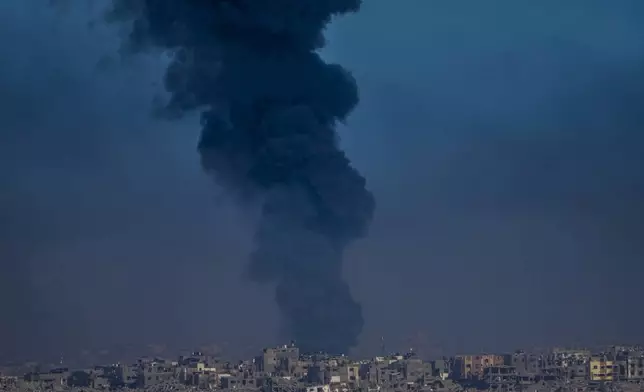JERUSALEM (AP) — Israel's prime minister, Benjamin Netanyahu, entered Syrian territory Tuesday and said Israeli troops would remain in the area indefinitely, blurring the border with its northern neighbor.
Since its establishment in 1948, Israel has never had fully recognized borders. Throughout its history, the frontiers with its Arab neighbors have shifted as a result of wars, annexations, ceasefires and peace agreements.
Now, the downfall of Syrian President Bashar Assad has created a situation that could once again reshape Israel’s borders.
As Assad was toppled early this month, Israel quickly moved into the Syrian side of a 50-year-old demilitarized buffer zone. Netanyahu described the move as defensive and temporary, and said it was aimed at making sure that none of the groups jostling for power inside Syria threatened Israel.
But in Tuesday’s visit to the Syrian side of the buffer zone, Netanyahu made clear that Israel plans on staying for some time. Speaking on the windswept summit of Mount Hermon overlooking Syria, he said Israel would remain “until another arrangement is found that will ensure Israel’s security.”
Here is a closer look at the evolution of Israel’s borders over the years.
In 1947, the United Nations approved a plan to partition what was then British-controlled Mandatory Palestine into Jewish and Arab states. The contested city of Jerusalem was to be administered by the U.N.
This plan, however, was never implemented. Israel declared independence in May 1948, and neighboring Arab countries declared war. That war ended with Israel in control of some 77% of the territory – with Jordan controlling the West Bank and east Jerusalem, and Egypt in control of the Gaza Strip.
During the six days of fighting of the 1967 Mideast war, Israel captured the West Bank and east Jerusalem from Jordan, Gaza and the Sinai peninsula from Egypt, and the Golan Heights from Syria.
Initially celebrated by Israel, the lightning victory set the stage for decades of conflict that continue to reverberate today.
Israel quickly annexed east Jerusalem – home to the city’s most sensitive Jewish, Muslim and Christian holy sites as well as its Palestinian population.
Although Israel has never formally annexed the West Bank, it has informally incorporated much of the territory by building settlements that are now home to over 500,000 Jewish Israelis.
The international community overwhelmingly considers both east Jerusalem and the West Bank occupied territory.
Israel also built settlements in the Sinai, Golan and the Gaza Strip.
Under Israel’s first peace agreement with an Arab country, Israel returned the Sinai peninsula to Egypt and dismantled all settlements there.
Israel annexed the Golan Heights, a strategic mountainous region overlooking northern Israel. In 2019, then-President Donald Trump became the first and only foreign leader to recognize Israel’s control. The rest of the world still considers the area occupied Syrian territory.
Netanyahu announced this week he wants to expand the Golan settler population after Assad’s downfall.
After a brief invasion of Lebanon against Palestinian militants in 1978, Israel reentered the country in 1982 in an operation that turned into an 18-year occupation of southern Lebanon. Israel withdrew in 2000 under heavy fire from the Hezbollah militia.
Israel and the Palestinians reached an interim peace deal granting the Palestinians autonomy in Gaza and parts of the West Bank, while leaving Israeli settlements intact. The accords were meant to pave the way for a two-state solution, but repeated rounds of peace talks ended in failure.
The Palestinians seek all of the West Bank and Gaza for their hoped-for state, with east Jerusalem as their capital.
Then-Prime Minister Ariel Sharon led a unilateral withdrawal from Gaza, uprooting all troops and 21 settlements from the territory. Two years later, Hamas militants overran Gaza and ousted the Palestinian Authority.
Responding to Hamas’ Oct. 7 cross-border attack, Israel invades Gaza in an operation that continues.
Israeli leaders have not laid out a clear postwar plan but have indicated they will maintain a buffer zone along Gaza’s border with Israel along with some sort of long-term military presence. Some hardliners in Netanyahu’s governing coalition have called for the re-establishment of Jewish settlements.
In October, Israeli ground troops invaded southern Lebanon after a year of fighting with Hezbollah militants. Under a ceasefire, Israel has pledged to withdraw from a strip of land it is occupying by late January.
As opposition forces ousted Assad on Dec. 8, Israeli military forces moved into the Syrian side of the demilitarized buffer zone, established after the 1973 Mideast war. Israel now controls the zone and targets deeper inside the country.
Although Israel has said the move is temporary, its open-ended presence has drawn international criticism from countries such as Egypt, Turkey and Saudi Arabia as well as the United Nations.
U.S. Secretary of State Antony Blinken has urged all countries with interests in Syria to “try to make sure that we’re not sparking any additional conflicts.”
The new Syrian government has already lodged a complaint with the U.N. Security Council about Israeli advances into Syrian territory. The leader of the largest insurgent group, Ahmad al-Sharaa, has publicly condemned Israel’s operations but said Syria is not seeking a military conflict with Israel.
Carmit Valensi, an expert on Syria at Israel's Institute for National Security Studies, said she does not think the Israeli presence will morph into a longer-term occupation. She said Israel has little to gain by provoking al-Sharaa, who is also known as Abu Mohammed al-Golani, and a long-term occupation would be costly economically and for Israel's war-fatigued army.
“It could take some time for Israel to withdraw. It depends how things develop in Syria,” she said. “If we see a moderate regime emerge, in the same line Golani is trying to pave, I don't see any reason to hold those territories for the long term.”

Israeli soldiers stand on an armored vehicle after crossing the security fence along the so-called Alpha Line that separates the Israeli-controlled Golan Heights from Syria, in the town of Majdal Shams, Tuesday, Dec. 17, 2024. (AP Photo/Matias Delacroix)

FILE - Smoke rises following an Israeli airstrike in the Gaza Strip, as seen from southern Israel, Dec. 29, 2023. (AP Photo/Ariel Schalit, File)

FILE - Israeli settler girls cry in the mud after being dragged away by Israeli army soldiers dismantling an illegal structure at an outpost outside the Jewish settlement of Yitzhar, near the West Bank town of Nablus, Jan. 3, 2005. (AP Photo/Kevin Frayer, File)

FILE - A view of Golan Heights in Israel, January 1982. (AP Photo/Max Nash, File)

FILE - Israel Minister, counter clockwise from foreground, Ariel Sharon, Agriculture; Ezer Weizman, Defense; Moshe Dayan, Foreign; Yigal Yadin, Deputy Premier; Menachem Begin, Premier; and Simha Erlich, Finance; raise their hands during a vote, ending the parliament session on the U.S. peace proposals for an agreement between Egypt and Israel in Jerusalem, March 22, 1979. (AP Photo/Max Nash, File)

FILE - In this photo released by the Government Press Office, Israeli troops advance towards Egyptian position in the southern Sinai during the Six Day War, June 1967. (AP Photo/Government Press Office, File)

FILE - Jewish people wave and cheer as they gather in the streets of Tel Aviv after radio broadcasts announce that the United Nations plans for the partition of Palestine and the new Jewish state, Nov. 30, 1947. (AP Photo/Jim Pringle, File)

Israel's Prime Minister Benjamin Netanyahu, left, visits Israeli forces in a buffer zone inside Syria, Tuesday, Dec. 17, 2024. (Israel Government Press Office via AP)



















